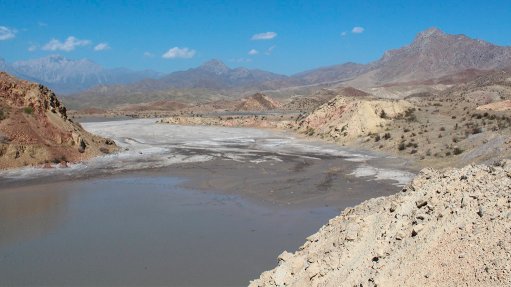
HEALTH CONCERNS The former Sumsar lead-zinc mining and ore processing area represents a constant threat of elevated exposures to chemical contaminants for the resident populations
A field mission to the former Sumsar industrial area, in Kyrgyzstan, has been carried out jointly by international nongovernmental mine action organisation the Swiss Foundation for Mine Action (FSD) and the Agency for Tailings Management of the Ministry of Emergency Situations of the Republic of Kyrgyzstan.
The aim of this inception mission was to investigate the current situation and conditions of the former lead and zinc mine, its technological tailing sites and their potential impact on the environment to obtain relevant and reliable information for proposing adequate remediation and rehabilitation activities in the Sumsar area.
Mission members visited the three tailings sites and public facilities (a kindergarten, a hospital and a water management enterprise in Sumsar), made visual inspections of the tailings sites and their environment, conducted drone flights over the entire area, carried out several in situ measurements and collected various environmental samples for analysis of chemical contaminants.
The mission found that the former Sumsar lead and zinc mining and ore processing area is located in an ecologically very sensitive environment and represents a constant threat of elevated exposures to chemical contaminants for the resident populations in the Sumsar valley.
“Imminent action and activities are recommended for the application of appropriate counter measures that would reduce contamination exposure levels and minimise the risk of developing health problem of the resident populations,” the mission said.
The main source of pollution is three legacy tailings storage facilities (TSFs) located within the living environment of the Sumsar valley. The tailings sites are not properly managed, as, for example, fences and signs do not exist and the sites are easily accessible by members of the general public.
The FSD says that “adequate and efficient” activities are recommended to improve the current situation through appropriate technical means, such as placing warning signs and protective fences that would prevent unauthorised visits to the sites.
TSF No 1 (the remaining part of its original size) is in the worst condition and it is located in very close proximity to the Sumsar river, which exposes it to various environmental and technogenic impacts and represents a serious threat for the living environment of the Sumsar valley, located downstream of TSF No 1.
Therefore, the mission recommends as “a priority action” that a translocation of TSF No 1 to a safer site be undertaken. Two translocation options should be considered. The first is a transfer to TSF No 2 or TSF No 3, in either case followed by the remediation works of the new (combined) site.
The mission noted that TSF No 2 was environmentally less problematic, mainly owing to its protective cover, but still had an impact on the environment because of diversion channels not properly maintained and both tailings dams, the surface of which was locally eroded and tailings materials washed away.
A general improvement of TSF No 2 is recommended, including repair of the tailings cover where necessary, revegetation of the surface, and cleaning and maintaining the diversion channels to minimise further impact on the nearby environment.
Further, TSF No 3 is a large open space surface area with finely dispersed tailings materials containing toxic trace elements as a main source of airborne contamination of nearby, as well as distant, areas in the Sumsar region.
This is a potential risk of a gradual or sudden collapse of the tailings into hollow underground spaces of the former mine shafts and chemical elements from the tailings materials migrating into the ground and some of them into surface (pond) water.
The mission found that the tailings dams were not in a satisfactory condition and advised that a protective cover of soil be placed on the tailings surface followed by suitable vegetation to prevent dissemination of dust particles in the environment.
“This could, however, be a very costly operation, but should be implemented at the earliest convenience of the availability of financial sources. In the present conditions, improvements in the dams’ stability, general maintenance, monitoring and institutional control of the site are recommended.”
Moreover, the results of the chemical analysis of the water samples showed acceptable concentrations of trace elements (below recommended limits) in the drinking water.
However, elevated concentration levels in the mine water and wash-out water from TSF No 2 indicated that these two specimens were the main contributors to pollution of the Sumsar aqueous environment.
The mission recommended that the inflow of the mine water into the Sumsar river be prevented and that the metal concentration levels be monitored on a regular basis. In this context, an automatic water monitoring station is planned to be installed through a European Community project at the water catchment area in the Yunus village.
“In addition to regular analysis of chemical components, a biological and bacteriological analysis is recommended to improve technical capabilities and facilities for safe provision and distribution of the drinking water in the area.”
Exposure to airborne dust particles from TSF No 3 and TSF No 1 is considered as a high health-related risk for the Sumsar residents.
“A complete chemical and particle size analysis of the tailings materials is being conducted and the results will possibly enable quantification of people’s exposure to toxic contaminants via inhalation. Quantification of results and assessment of exposure to airborne contaminants after completion of analysis are recommended,” the mission concluded.